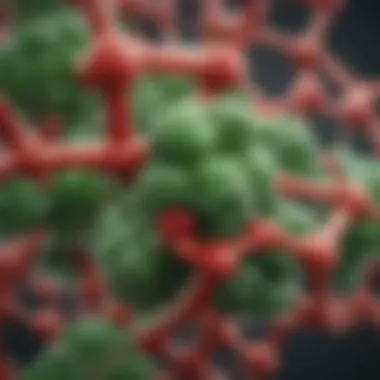Understanding Paraquat: Mechanisms and Implications


Intro
Paraquat stands out in the realm of herbicides. Renowned for its potency, it has engraved itself deeply into the practices of many within agriculture and horticulture industries. However, its reputation is not without controversy. This powerful agent fights against stubborn weeds but comes with a shadow of safety concerns that cannot be ignored. Understanding the mechanisms behind paraquat and its implications is crucial for anyone who works the soil.
This article explores how paraquat interacts on a biochemical level, how it operates within plants, and the environmental effects that follow its application. By providing a thorough examination, we aim to equip farmers, horticulturists, and sustainability advocates with the insights needed to navigate the challenges surrounding paraquat.
Key Insights
Overview of the Topic
To put it simply, paraquat is a non-selective herbicide—meaning it doesn't discriminate; it will take out any green leaf it encounters. Its primary mode of action involves disrupting the photosynthesis process in plants. This herbicide enters the plant through its leaves, generates reactive oxygen species, and ultimately leads to cell damage and death.
It's worth noting that paraquat is highly effective for controlling various weed species. This efficacy draws many land managers to its side, making it a favorite amidst growers tackling perennial weeds and those looking to clear fields before planting.
Importance in Agriculture/Horticulture/Agronomy
The agricultural world is a constant battle against pests and weeds. Paraquat’s ability to offer fast results makes it a go-to solution for farmers pressed for time. The mere application can lead to visible results within a day, helping crops to breathe and grow unencumbered.
However, while the herbicide boasts advantages, the implications of its usage cannot be dismissed. Cases of toxicity and environmental degradation have arisen, urging farmers to weigh their options. Therefore, adopting safety measures and understanding how to use paraquat responsibly is not just beneficial but essential for long-term sustainability.
Sustainable Practices
Eco-Friendly Techniques
One of the pressing concerns with paraquat is the environmental footprint it leaves behind. To counterbalance this, eco-friendly techniques are coming to the forefront. Some of these methods include:
- Integrated Weed Management: Combining mechanical methods, cover crops, and organic herbicides to reduce reliance on chemicals.
- Precision Application: Utilizing methods that minimize drift and target only the areas needing treatment.
- Maintaining Buffer Zones: Establishing zones where no chemicals are applied can help protect surrounding flora and fauna.
Implementing such techniques allows farmers to maximize efficiency while mitigating negative effects.
Case Studies on Sustainability
In various parts of the world, farmers have successfully integrated sustainable practices with paraquat. For instance, a group of Brazilian farmers adopted a method combining cover crops and paraquat for weed control. This partnership not only kept their fields clean but also retained soil health, reducing erosion significantly.
Moreover, a study published in Agricultural Systems highlighted an Australian cotton farm that applied paraquat using precision application techniques. As a result, they witnessed a remarkable reduction in pesticide usage and improved overall crop yields.
Tools & Resources
Essential Equipment and Technologies
Utilizing paraquat effectively requires certain tools:
- Sprayer Technology: Proper calibration of sprayers ensures that the appropriate dose reaches the target.
- Protective Gear: Ensuring all handlers are equipped with gloves, masks, and goggles can minimize health risks associated with exposure.
Recommended Books and Readings
For those keen on diving deeper, consider these recommendations:
- "Pesticide Application: Principles and Practices" - A guide that covers various pesticides, including paraquat.
- "Weed Management in Organic Farming Systems" - A resource emphasizing sustainable weed control methods.
Understanding paraquat's role in agriculture requires a balanced view—embracing its strengths while critically assessing its impact is key.
Overview of Paraquat
Paraquat is a widely utilized herbicide, particularly in the realms of agriculture and horticulture. Understanding its mechanics and implications is paramount for farmers, agronomists, and environmentalists alike. The importance of this topic lies not just in its effectiveness at controlling weeds, but also in the broader ramifications it holds for ecosystems and human health.
The significance of Paraquat can be traced through many facets: its chemical structure, the historical context of its use, its interactions within plant systems, and the impacts on the surrounding environment. Exploring these areas equips stakeholders with essential insights needed for informed decision-making. Farmers looking to maximize yield while minimizing ecological damage must delve into these aspects.
Chemical Structure and Properties
Paraquat's chemical structure is distinctive, characterized by its bipyridyl compound formation. As a contact herbicide, it operates by damaging the cellular membranes of plants, leading to rapid desiccation. The molecular formulation consists of two pyridine rings, which are responsible for its high reactivity. Due to its positive charge, Paraquat is highly mobile in aqueous systems, making it effective in varied agricultural landscapes. It's this chemical behavior that allows Paraquat to penetrate leaf tissues efficiently, which is crucial for its role in weed management.
This herbicide possesses unique properties, such as its solubility in water, which further accentuates its utility in cropping practices, but also raises concerns about its persistence in the environment. Understanding these properties helps in assessing the chemical's role and safety in agriculture, especially in relation to soil and water usage.
Historical Context of Usage
The history of Paraquat goes back several decades. Introduced in the 1960s, it quickly gained traction among farmers who grappled with stubborn weed populations. Its initial promise lay in its ability to control a wide range of annual weeds with remarkable efficacy, marking it as a game-changer in weed management strategies.
However, as its usage proliferated, so did the reports of adverse health effects. The twin edges of effectiveness and peril have shaped its journey throughout the years. Many countries adopted strict regulations in response to health concerns, leading to a patchwork of acceptance and bans globally.


Today, understanding the historical context of Paraquat, from its introduction and rapid acceptance to the growing scrutiny and restrictions applied to it, is crucial. This underlines not only the importance of safe application practices but also the need for continued research on safer alternatives. As modern agricultural paradigms shift towards sustainability, the lessons from Paraquat’s history are invaluable for guiding future practices.
Mechanism of Action
Understanding the mechanism of action of paraquat is crucial for grasping its role in agriculture and the implications it has for plant health and environmental safety. Paraquat operates primarily through its ability to disrupt normal plant functions, notably through its interference with photosynthesis. This section elaborates on how paraquat affects various biochemical processes, offering a detailed look into its operational dynamics.
Photosynthesis Interference
At the heart of paraquat’s herbicidal effectiveness lies its pronounced interference with photosynthesis—the process by which plants convert light energy into chemical sustenance. Paraquat's molecular structure allows it to mimic certain substrates that plants utilize during photosynthesis. When applied, paraquat is absorbed through leaf surfaces, where it interacts with the photosystem II complex in chloroplasts. This interference inhibits the production of energy-rich compounds by essentially obstructing the flow of electrons during photosynthesis.
Key Considerations:
- Rapid Action: Paraquat acts quickly, often killing weeds within days of application. This speed can be advantageous for farmers needing immediate control over invasive species.
- Selectivity: While paraquat is effective against many unwanted plants, its selectivity allows for targeted applications, ideally preserving desirable crops.
"Understanding how paraquat disrupts photosynthesis not only reveals its potency as a herbicide but also cautions users about potential impacts on surrounding plants."
Reactive Oxygen Species Generation
The application of paraquat incites the generation of reactive oxygen species (ROS), which are wildly unstable molecules that wreak havoc on cellular structures. When paraquat is reduced by electrons provided during the photosynthetic process, it becomes a potent oxidant, ultimately leading to an overproduction of ROS. These species can cause significant oxidative stress, damaging proteins, lipids, and nucleic acids within plant cells.
Implications of ROS:
- Cellular Damage: This oxidative damage results in wilting and browning of leaves, often serving as a visible sign of paraquat’s lethal action.
- Effects on Growth: The stress inflicted by ROS hinders the plant's overall growth and development, leading to eventual death if the exposure is substantial and prolonged.
Impact of Electron Transport Chain
Paraquat's mechanism extends to the electron transport chain, an essential series of complexes involved in energy transfer within cells. By intercepting electrons, paraquat disrupts this chain, leading to an inefficient transfer of energy necessary for cellular activities. This disruption not only affects photosynthesis but can also lead to a cascade of metabolic dysfunctions.
Consequences:
- Energy Crisis: The disruption results in a loss of adenosine triphosphate (ATP), the energy currency for the cell, crippling the plant's ability to maintain vital functions.
- Altered Metabolism: An interruption in the electron transport chain affects numerous biochemical pathways, impeding vital processes like respiration and nutrient uptake.
In sum, the mechanisms of action for paraquat are a complex web of interactions that highlight its effectiveness as a herbicide, while also underscoring the importance of careful management and understanding among users. The consequences of its application stretch beyond just the targeted weeds, bringing to light the implications for broader plant health and ecological balance.
Pathways of Uptake in Plants
Grasping the pathways of uptake in plants is pivotal for comprehending how paraquat functions as a herbicide and influences agricultural practices. This section elucidates the mechanisms through which paraquat enters plants, the implications of these mechanisms for weed control, and their significance in sustainable farming.
Paraquat operates primarily through two main routes: foliar application and root absorption. Understanding these pathways is essential not just for enhancing efficacy but also for mitigating adverse effects on non-target plants and the environment.
Foliar Application Technique
The foliar application of paraquat is a widespread practice in agriculture. This method allows for direct contact with the leaves of weeds, facilitating rapid absorption. When applied, paraquat penetrates the leaf surface and enters the plant cells. Factors that enhance the effectiveness of this method include the droplet size, application timing, and environmental conditions such as humidity and temperature.
Using the right sprayer settings ensures even distribution and optimal coverage, which are crucial for maximizing the herbicide's effectiveness. It's also vital to consider the timing of application—applying paraquat when weeds are actively growing ensures higher absorption rates. However, users must be cautious about potential drift, which can affect nearby plants and ecosystems.
Moreover, selecting appropriate adjuvants can help improve paraquat's penetration capabilities. Certain surfactants enhance leaf wetting and facilitate deeper absorption, which can decrease the required dosage for successful weed control. This can be beneficial for preserving resources while simultaneously minimizing environmental impact.
"Effective foliar application requires a nuanced understanding of plant physiology and environmental factors."
Root Absorption Mechanism
Root absorption is another critical pathway for paraquat uptake, particularly in cases where the herbicide may be inadvertently taken up by the desired crop. While paraquat is applied primarily to the foliage, the potential for root absorption cannot be overlooked.
In scenarios where ground application occurs or where the herbicide leaches into the soil, plants can absorb paraquat through their root systems. This unintentional uptake can lead to phytotoxicity in crops, underscoring the necessity of applying paraquat judiciously.
Factors influencing root absorption include soil composition, moisture levels, and the overall health of the root system. Compacted or poorly structured soils may impede absorption and influence how effectively plants can uptake water and nutrients, sometimes exacerbating herbicide toxicity in unintended species.
Understanding these pathways also aids in developing integrated pest management strategies. For instance, following rainfall or irrigation, there's a higher risk of paraquat leaching into the root zone of crops. Hence, better management practices can be implemented to minimize such risks, fostering a more sustainable approach to herbicide use.
In summary, comprehending the pathways of uptake in plants equips farmers and agricultural specialists with the knowledge to optimize paraquat use. This understanding paves the way for implementing necessary precautions while ensuring that the application remains effective in managing unwanted weeds.
Environmental Impact
Understanding the environmental impact of paraquat is crucial, not just for effective agricultural practices but also for broader ecological health. Paraquat's future in farming hinges on our grasp of its multi-faceted influence in various environments.
Soil Mobility and Persistence
Paraquat is known for its unique behavior when it interacts with soil. It possesses a strong affinity for soil particles, which greatly limits its mobility. This characteristic means that once applied, paraquat tends to remain in the same location rather than leaching into groundwater. However, its persistence can play a double-edged sword; while reduced mobility helps prevent contamination of water sources, it also means the chemical can remain in the soil for prolonged periods, affecting subsequent crops.


Research indicates that the degradation of paraquat in soil hinges on environmental factors like temperature, moisture levels, and microbial activity. So, under specific conditions, paraquat can degrade at a faster rate, becoming less harmful over time. This draws attention to the importance of site-specific management. Farmers can enhance the biodegradation of paraquat by implementing practices such as cover cropping and crop rotation.
Effects on Non-Target Species
One of the most significant considerations regarding paraquat usage is its potential impact on non-target species. Although primarily designed for weed control, the herbicide can inadvertently affect beneficial insects, soil organisms, and even small mammals. Some studies have suggested that when paraquat is sprayed, it can affect bees and other pollinators, leading to a decline in these populations. This possible decline can then ripple through ecosystems, affecting plant reproduction and diversity.
To mitigate these impacts, better scheduling of applications in terms of timing and meteorological conditions can help reduce non-target exposure. Alternately, exploring integrated pest management (IPM) strategies may offer avenues for farmers to manage weed populations while protecting ecological balance.
Water Contamination Risks
Water contamination is another pressing concern when discussing the environmental aspects of paraquat. Even though paraquat is less mobile in soils, there’s still a risk associated with runoff, especially after heavy rains. Contaminated water sources not only affect agricultural viability but also pose serious health risks to humans and animals alike.
Agricultural runoff can carry paraquat and residues into rivers, streams, and lakes, resulting in potential bioaccumulation within aquatic ecosystems. These risks necessitate stringent guidelines for application, including buffer zones near water bodies and active monitoring of nearby water sources.
"The responsibility to manage paraquat effectively extends beyond the individual farm and touches upon communal and environmental stewardship."
Farmers must be proactive in implementing conservation practices that can help prevent runoff, including the use of cover crops and maintaining ground cover. These steps can collectively enhance soil health and protect our water resources, ensuring that we manage paraquat's benefits and risks effectively.
Toxicological Profile of Paraquat
Understanding the toxicological profile of paraquat is essential in addressing its use, especially given its potent nature. In agriculture, it's widely regarded for its efficacy in weed control, but significant concerns linger about its health implications. From acute exposure incidents to chronic health effects that might not surface immediately, the stakes for farmers, handlers, and even the ecosystems are high. The intricate balance between achieving agricultural goals and ensuring safety is a prime subject of scrutiny.
Acute Toxicity Parameters
Acute toxicity refers to the immediate harm that can occur after a single exposure to a harmful substance. In the case of paraquat, contact is often through inhalation, ingestion, or dermal routes. The LD50, a common measurement to express a substance’s acute toxicity, is notably low for paraquat compared to many other herbicides. Specific figures indicate that oral ingestion of paraquat can lead to significant health hazards, with estimates ranging from 30 to 50 mg/kg being critical for human and animal life.
Some symptoms of acute exposure include:
- Respiratory distress: This can manifest through coughing, wheezing, and in severe cases, pulmonary edema.
- Gastrointestinal distress: Ingesting paraquat can lead to nausea, vomiting, and gastric irritation.
- Kidney and liver damage: These organs can suffer significant harm shortly after exposure, which may lead to prolonged health complications.
Important Note: Prompt medical attention is critical in mitigating the effects of paraquat poisoning. Without immediate intervention, outcomes can be fatal.
Chronic Health Effects
Chronic health effects refer to long-term or repeated exposure consequences. While the acute impacts are often more noticeable, chronic effects are insidious and may go unnoticed until they present significant health issues later on. Individuals working regularly with paraquat may experience
- Lung fibrosis: Long-term inhalation is particularly dangerous, resulting in a scarred lung tissue that limits airflow.
- Skin disorders: Prolonged skin contact can lead to dermatitis or even more severe skin conditions.
- Neurological effects: Some studies suggest a potential link between paraquat exposure and neurodegenerative diseases, notably Parkinson's disease.
While regulatory bodies and safety guidelines aim to mitigate these risks, gaps still persist in monitoring occupational exposure and enforcing stringent safety practices. Farmers and agricultural workers need to remain vigilant, understanding that the cumulative effect of regular paraquat use can compound health risks over time.
Safety Measures for Application
The application of paraquat, while effective in weed management, necessitates a keen focus on safety protocols. This herbicide, with its high toxicity, poses risks not only to the personnel applying it but also to the surrounding environment and non-target species. Therefore, implementing stringent safety measures is critical to mitigate these risks and ensure proper handling, transport, and application procedures. Attention to safety can significantly reduce the chances of accidents, illnesses, and environmental contamination.
Protective Equipment Recommendations
When working with paraquat, it is imperative to equip oneself with appropriate personal protective equipment (PPE). Wearing suitable gear forms the first line of defense against potential exposure. Recommended equipment includes:
- Chemical-resistant gloves: These neck-length gloves made from materials like nitrile help prevent skin contact with paraquat.
- Protective eyewear: Safety goggles designed to shield against splashes and airborne particles are essential for safeguarding the eyes.
- Respirators: For heavy usage situations, N95 masks or higher-level respirators can filter out harmful particles and vapors.
- Body coveralls: Full-body suits made of breathable, chemical-resistant fabric can minimize skin exposure.
It is vital to regularly inspect this protective equipment, ensuring it remains intact and effective against corrosive substances. Routine care can extend the usable life of the gear while maintaining safety standards.
Best Practices for Handling
Handling paraquat ought to follow strict guidelines to prevent accidents and exposure. Adhering to best practices is not just advisable; it is essential for safety. Some key practices include:
- Read the label: Understanding the information provided on the product label is non-negotiable. It carries vital instructions regarding dilution, application rates, and emergency measures.
- Avoid handling near food: Keep paraquat away from food preparation areas and utensils to prevent contamination.
- Mixing and loading: Always prepare solutions in well-ventilated areas and, if possible, outdoors. Use dedicated tools to measure and mix, and never use them for food preparation afterward.
- Emergency equipment: Maintain access to emergency washing stations and first aid kits in areas where paraquat is stored or applied.
- Proper disposal: Dispose of any unused paraquat solutions according to local regulations. This may involve returning it to a designated collection site or disposing of it at a hazardous waste facility.
"Handling pesticides with care and respect for their potency can minimize unintended harm to both the handler and the environment."
Incorporating these practices into the routine of anyone working with paraquat not only prioritizes individual safety but also contributes to a more conscientious approach to agricultural management.
Regulatory Landscape
Understanding the regulatory landscape surrounding paraquat is crucial for anyone involved in agricultural practices. These regulations are not merely bureaucratic in nature; they play a significant role in shaping how this herbicide is utilized. Safety measures, application guidelines, and bans can profoundly influence both farming efficiency and environmental sustainability. Thus, navigating these regulations helps stakeholders make informed decisions that balance productivity with ecological considerations.
Global Restrictions and Bans
Globally, the use of paraquat has come under heightened scrutiny due to its toxicological profile. Over the years, several countries have instituted bans or severe restrictions on its use. For instance, the European Union has placed a complete ban on paraquat, citing risks to human health and environmental safety. This move has sparked dialogue on alternatives, pushing many nations to explore other herbicides or integrated pest management strategies that align with sustainable practices.


Countries like China and Brazil still permit paraquat usage, but under strict regulations. Some of the limitations include stringent certification processes for applicators and mandatory safety measures to prevent exposure. This fragmentation of regulation leads to significant discrepancies in agricultural practice, influencing not just local farming economies but also global agronomy trends.
"The choice to restrict or ban paraquat directly echoes the broader agricultural policies in place, and the push towards sustainability in farming."
Labeling and Usage Guidelines
To minimize risks, proper labeling and usage guidelines for paraquat are vital. These guidelines typically include detailed instructions on appropriate safety equipment, dilution rates, and application methods to reduce toxicity risks to both users and bystanders. Additonally, labels often stress the importance of adhering to local regulations for paraquat application, providing clear instructions to mitigate potential negative impacts.
A well-crafted label should offer clear information on:
- Reapplication intervals: Understanding waiting periods helps farmers comply with both safety measures and crop scheduling.
- Protective gear: Specific requirements, such as gloves, goggles, and masks are often highlighted, ensuring that applicators safeguard their health while handling the chemical.
- In case of incidents: Guidance on emergency procedures must be displayed, offering actionable steps if exposure occurs.
By adhering to these guidelines, farmers not only enhance their operational safety but also contribute to greater sustainability in agricultural practices. Effective communication of safety measures can significantly minimize risks associated with this herbicide, ultimately making it a more responsible choice for managing weed populations.
Comparative Analysis with Other Herbicides
A comparative analysis of paraquat with other herbicides sheds light on its unique role within agricultural practices. Understanding how paraquat stacks up against alternatives not only informs farmers and agricultural enthusiasts about effective weed management but also helps in making educated decisions regarding the safety and sustainability of crop production.
Efficacy and Cost-Effectiveness
When it comes to efficacy, paraquat has carved a niche for itself as a potent herbicide. Its ability to control a wide range of weeds makes it a preferred option among many farmers. Some herbicides, like glyphosate, also demonstrate a broad-spectrum efficacy. However, paraquat's rapid action often leads to quicker results, resulting in more immediate impacts on weed populations.
In terms of cost-effectiveness, paraquat is often favorable. Although upfront costs may seem higher, its efficiency and speed in targeting resistant weeds can lead to reduced expenditures over time. Farmers can spend less on multiple applications when a single treatment of paraquat suffices. However, these economic decisions should be balanced against the potential environmental risks and regulatory scrutiny associated with its use.
- High Initial Efficacy: It provides swift results, particularly in dealing with established weed infestations.
- Cost Advantages: A single application can suffice, trimming down labor and product costs across the growing season.
"While efficacy and cost are paramount, one must not overlook the ramifications of using chemicals in a broader ecological context."
Environmental and Health Considerations
Despite its benefits, paraquat raises considerable environmental and health concerns that warrant a thorough examination. Compared to other herbicides, such as atrazine or imazapyr, paraquat is notorious for its high toxicity levels. This can lead to potential risks for those applying the herbicide as well as for non-target species, including beneficial insects and plants.
In addition to direct toxicity to humans and animals, there are significant ecological implications. Parquat can persist in the environment and has been linked to water contamination. In contrast, some alternatives—like organic herbicides—may present lower toxicity but often require more frequent applications, raising their overall environmental footprint through increased labor, resource use, and potential runoff.
It is essential to weigh these factors appropriately:
- Acute Toxicity: Paraquat poses immediate health risks upon exposure compared to some slower-acting alternatives.
- Long-Term Impact: Its linkage to water pollution challenges growers to consider regulatory compliance and market trends favoring sustainable practices.
- Ecological Balance: The risk to non-target organisms can disrupt local ecosystems and reduce biodiversity, which can have cascading effects on crop health and yield.
Future Directions in Paraquat Research
The exploration of future directions in paraquat research holds great significance not just for the agricultural sector but also for environmental and health safety considerations. As debates around the usage of paraquat continue to intensify, there is a pressing need to focus on innovative research avenues that can address both efficacy and safety concerns. By understanding and improving the formulations, identifying sustainable alternatives, and enhancing applicator safety, researchers can contribute to a more responsible and effective use of this herbicide.
Novel Formulations
The advancement of novel formulations of paraquat may play a paramount role in mitigating some of the associated risks while maintaining its herbicidal efficacy. Recent studies have proposed several improvement strategies, including:
- Controlled-Release Formulations: These formulations aim to minimize rapid penetration into the soil and plants, balancing effectiveness with reduced toxicity. Such designs allow paraquat to act over a longer duration, potentially decreasing the frequency of applications required.
- Nano-Encapsulation Technologies: Encapsulating paraquat at the nanoscale can improve its delivery to weed targets while reducing collateral damage to non-target species. Such systems can enhance the herbicide’s absorption and effectiveness, ultimately leading to lower environmental concentrations.
- Plant-Powered Adjuvants: Integrating naturally derived adjuvants can enhance the herbicide's effectiveness while also increasing safety. This approach not only reduces the reliance on synthetic chemicals but also aligns with increasingly popular organic farming practices.
Sustainable Alternatives
As the agricultural sphere focuses on sustainability, identifying sustainable alternatives to paraquat has garnered attention. Here are some exciting avenues being pursued:
- Bioherbicides: Derived from natural materials, bioherbicides offer potential as effective weed management tools. They usually target specific weed species while posing less risk to non-target plants and animals. For example, using fungal spores or extracts from plants that inhibit weed germination could ensure lower environmental impact.
- Integrated Weed Management: Combining physical, cultural, and biological control methods is another promising alternative. Techniques such as cover cropping, mulching, and crop rotation for controlling weeds can reduce reliance on chemical herbicides, including paraquat.
- Green Chemistry Innovations: The principles of green chemistry aim to design products that reduce waste and avoid hazardous substances. By developing practices that prioritize safety and sustainability, research can guide the future of herbicide use toward a more eco-friendly path.
"The future of herbicides like paraquat lies in balancing efficiency with responsibility, ensuring that agricultural practices are sustainable for generations to come."
In summary, future research on paraquat is not merely about enhancing its current applications but is rather focused on creating a paradigm shift towards safer and more sustainable agricultural practices. As the intensity of agricultural production increases, so does the necessity for innovative solutions that can align the needs of farmers with ecological integrity.
Epilogue
The conclusion of this article emphasizes the pressing need to comprehensively understand paraquat, not only its mechanisms of action but also its implications for both safety and environmental integrity. This comprehensive analysis clarifies the multifaceted nature of paraquat, providing valuable insights for everyone involved in agriculture and horticulture. The prevailing narrative around this herbicide has often been marred by controversy and misinformation. Hence, a detailed examination can furnish stakeholders with the knowledge necessary to make informed choices regarding its application and regulation.
Understanding paraquat goes beyond mere comprehension of its chemical properties; it encapsulates the broader ramifications of its use on ecosystems and human health. Insights gleaned throughout this article inform about its effectiveness in weed management as well as highlighted hazards that warrant due diligence. In highlighting the inherent risks associated with paraquat, we underline the critical importance of proper application techniques, safety protocols, and awareness of potential chronic health effects.
Ultimately, awareness fosters responsibility. This article aims to serve as a foundational guide, inviting individuals to reflect on the implications of paraquat use. Stakeholders can navigate the intricate balance between effective agricultural practices and sustainable stewardship of our environment. Through disseminating knowledge, we encourage practices that ensure welfare not only for crops but also for the surrounding ecosystems and communities.
Summary of Key Insights
- In examining paraquat, we identified its mechanisms of action, particularly its interference with photosynthesis and the generation of reactive oxygen species.
- The herbicide's pathways of uptake and its potential for environmental persistence have important implications for non-target species and water resources.
- We also discussed regulatory perspectives, which vary globally, governing the application and safety measures surrounding paraquat use.
- The juxtaposition with other herbicides has underscored climatic and health considerations in comparing efficacy.
- Future research directions include exploring novel formulations and sustainable alternatives that could mitigate the adverse effects associated with paraquat.
Recommendations for Stakeholders
- Engage in Training: Stakeholders, especially farmers, should pursue training sessions that focus on the safe handling and application of paraquat. Understanding how to minimize exposure is paramount.
- Utilize Protective Equipment: It is crucial to prioritize the use of recommended protective gear during paraquat application to mitigate health risks.
- Analyze Alternatives: Consider exploring alternative herbicides and integrated pest management strategies that may reduce reliance on paraquat.
- Stay Updated on Regulations: As regulations surrounding paraquat may change, staying informed can assist stakeholders in adhering to new guidelines effectively.
- Monitor Environmental Impact: Engaging in practices that evaluate the environmental impact of herbicides in your area can provide critical data that might influence future agricultural strategies.
Paraquat, when used judiciously and safely, can continue to be an effective tool. However, this article stresses the necessity for careful consideration and responsible usage to promote a sustainable agricultural future.







